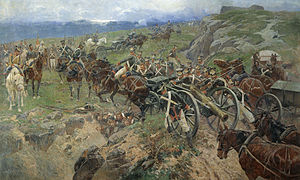Russo-Persian War (1804-1813)
| date | 1804 to 1813 |
|---|---|
| place | Transcaucasia , Northern Iran |
| output | Victory of the Russian Empire |
| Peace treaty | Peace of Gulistan |
| Parties to the conflict | |
|---|---|
The Russo-Persian War, from 1804 to 1813, was the third in a series of wars between the Russian Empire and Persia known as the Russo-Persian Wars . The war was about supremacy in the Caucasus .
causes
After the death of Karim Khan , a Zand Rulers of southern Persia, began Aga Mohammed Khan from the tribe of Qajar in 1779 with the unification of Persia. In 1794 he had eliminated all of his rivals, including the last Zand prince, Lotf Ali Khan , and extended Persian influence to Kartlien - Kakheti , Armenia and parts of Azerbaijan . In 1796 he was crowned Shah. He was murdered in 1797, followed by his nephew Fath Ali Shah . He wanted to expand the borders of Persia beyond the previous ones.
The Shah claimed the Karabag , Shirvan , Talysh and Sheki khanates . As a result, the Persians came into conflict with Russia, which had annexed Kartlien-Kakheti in 1801, which was also claimed by Persia. Now the Russians wanted to advance militarily to the south in order to expand their borders to the Aras River .
Starting position
Russia could not allow itself to move a large part of its troops to the Caucasus, since the main focus of Tsar Alexander I was on conflicts in Europe with France , Sweden and the Ottoman Empire . Therefore, the Russian army had to rely on superior technology in order to be able to hold its own against the numerically stronger Persian army. The Persian Prince Abbas Mirza tried to modernize the Persian army with the help of French and British experts, but did not succeed in time. The Persian army consisted largely of disorganized cavalry .
course
The war was triggered by the attack by Russian commanders Ivan Gudowitsch and Pawel Zizianow on Echmiadzin , the holiest city in Armenia. At that time the city was part of the Yerevan Khanate , which was under Persian suzerainty. The siege was called off because the troops were insufficient. After the unsuccessful siege of Etchmiadzin Gudowitsch moved on to Yerevan , which he could not take either.
Fath Ali Shah turned to the United Kingdom for political and military assistance. However, that refused a military agreement with Persia, as it was allied with Russia. Fath Ali Shah then asked for support in France, which was at war with Great Britain, Prussia and Russia, and sent a delegation to Napoleon Bonaparte , who at the time was staying in Finckenstein Castle in East Prussia. Napoleon concluded the Franco-Persian Alliance there on May 4, 1807 with the Treaty of Finckenstein , in which Persia was promised extensive military and material support. In return, Persia should declare war on Britain and expel all British citizens from Persia. Furthermore, Persia was to influence Afghanistan to carry out a joint Franco-Persian-Afghan invasion of India .
After the Russian troops suffered a heavy defeat in the Battle of Friedland against Napoleon's army on June 14, 1807 , Czar Alexander I then started negotiations with the French side, which first led to an armistice on June 23 and then on July 7 1807 led to the Peace of Tilsit . With this peace agreement, France and Russia became allies. In the peace of Tilsit, Georgia is not mentioned at all. Napoleon had offered Fath Ali Shah to mediate on the Georgia question. Russia agreed to a peaceful settlement of the disputed issues. But Fath Ali Shah insisted that peace with Russia would only be possible if Georgia were completely ceded to Iran. Fath Ali Shah concluded a new alliance agreement with the British in 1809, which provided that Iran abandoned the alliance with France. The British were reluctant to provide military support against Russia.
In 1810 the Persians declared war a "holy war". Even so, the Russians continued to win, such as the capture of Lənkəran . Despite the smaller Russian army strength of a maximum of 10,000 men, the Russians were able to use their advantages in technology and strategy and thus win the war. However, the Persians were able to offer strong resistance, so that the war dragged on until 1813.
Result
After the Persian surrender on October 12th, Jul. / October 24, 1813 greg. signed the peace of Gulistan , which allowed Russia to extend its territory to the Kura and Aras rivers . In the following period, the khans of Azerbaijan were gradually deposed or died, so that the areas became Russian provinces. In addition, Russia was granted the sole right to sail the Caspian Sea with warships, which made the Caspian Sea in fact a Russian lake.
In 1828 another Russian-Persian war broke out . This also ended with a defeat of Persia.
See also
literature
- N. Dubrowin. История войны и владычества русских на Кавказе, Volumes 4–6. SPb, 1886-88.
Web links
Individual evidence
- ↑ Ruholla K. Ramazani: The foreign policy of Iran. University Press of Virginia, 1966, pp. 41f.
